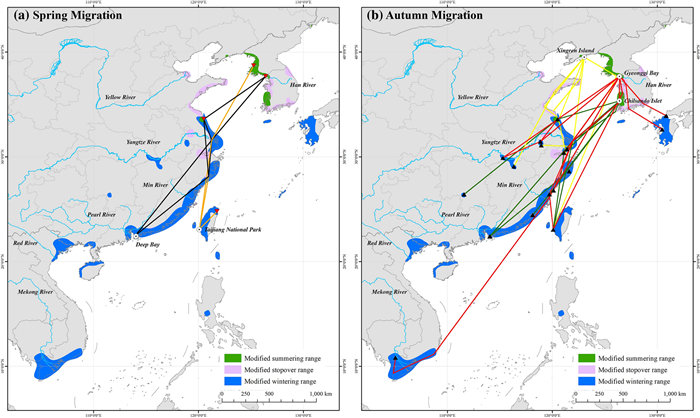
The migration routes taken by tracked Black-faced Spoonbills (Platalea minor), based on telemetry data from 34 individuals reported in the literature (see "Methods" for details). a Spring migration, including 10 tagged individuals captured at 2 wintering sites: Hong Kong (Deep Bay, n = 6, black) and Taiwan (Taijiang National Park, n = 4, orange) in China. b Autumn migration, including 24 tagged individuals captured at three breeding sites: Chilsando Islet (n = 8, dark green) and Gyeonggi Bay (n = 10, red) in South Korea and Xingren Island in Liaoning Province, China (n = 6, yellow). Dot-centred circle = the capture sites. Revised summering, wintering, and stopover ranges are shown in green, blue and light purple, respectively. The red inverted and black regular triangles = summer and wintering sites, respectively, used by tracked individuals. The names of all the capture sites and main rivers are shown on the map. All lines are shown as the shortest distances between two sequential fixes, which may not represent the precise routes taken by the birds concerned
Figures of the Article
-
![]() Revised distribution map of the Black faced Spoonbill (Platalea minor) in East Asia. Summering areas (the west coast of Korean Peninsula, and Xingren Island in Liaoning and Yancheng NNR in Jiangsu Province, China, and Furugelma Island in Russia) are shaded green. Wintering ranges (the west coast of Japan, Jeju Island in South Korea, the east and south coast of China, Yangtze River floodplain, Taiwan of China, Red River Delta and south coast in Vietnam, south coast in Cambodia, south in Thailand and north in Philippines) are shaded blue. Distributions are shown modified from previous maps from BirdLife International and Handbook of Birds of the World (2019, shown as hatching and cross-hatching). Revisions to summer and winter ranges are based on tracking data from the literature (red triangles denote GPS points from when each individual arrived and when they departed the summering and wintering grounds) and field surveys data (yellow circles, including data from Hong Kong Bird Watching Society and data from literature, while Yangtze waterbird survey points were not shown because no Black-faced Spoonbills were counted, see "Methods" for details). All the summering and wintering site/area names mentioned in the paper are shown on the map
Revised distribution map of the Black faced Spoonbill (Platalea minor) in East Asia. Summering areas (the west coast of Korean Peninsula, and Xingren Island in Liaoning and Yancheng NNR in Jiangsu Province, China, and Furugelma Island in Russia) are shaded green. Wintering ranges (the west coast of Japan, Jeju Island in South Korea, the east and south coast of China, Yangtze River floodplain, Taiwan of China, Red River Delta and south coast in Vietnam, south coast in Cambodia, south in Thailand and north in Philippines) are shaded blue. Distributions are shown modified from previous maps from BirdLife International and Handbook of Birds of the World (2019, shown as hatching and cross-hatching). Revisions to summer and winter ranges are based on tracking data from the literature (red triangles denote GPS points from when each individual arrived and when they departed the summering and wintering grounds) and field surveys data (yellow circles, including data from Hong Kong Bird Watching Society and data from literature, while Yangtze waterbird survey points were not shown because no Black-faced Spoonbills were counted, see "Methods" for details). All the summering and wintering site/area names mentioned in the paper are shown on the map
-
![]() Distribution map of the migration staging areas used by Black-faced Spoonbills (Platalea minor) in East Asia (light purple) (southwest coast of Korean Peninsula and northeast of Han River, East China, including the Yellow River Delta in Shandong Province, and the coastal area from Rongcheng, Shandong Province to Pearl River Delta). The distribution is based on data mapped by BirdLife International and Handbook of Birds of the World (2019, indicated by hatching) updated based on data presented here. The revised stopover range is based on tracking data (red triangles denoting GPS points generated during the stopover period) and field surveys data (yellow circles, see "Methods" for details) from literature. All the stopover site/area names mentioned in the paper are shown on the map
Distribution map of the migration staging areas used by Black-faced Spoonbills (Platalea minor) in East Asia (light purple) (southwest coast of Korean Peninsula and northeast of Han River, East China, including the Yellow River Delta in Shandong Province, and the coastal area from Rongcheng, Shandong Province to Pearl River Delta). The distribution is based on data mapped by BirdLife International and Handbook of Birds of the World (2019, indicated by hatching) updated based on data presented here. The revised stopover range is based on tracking data (red triangles denoting GPS points generated during the stopover period) and field surveys data (yellow circles, see "Methods" for details) from literature. All the stopover site/area names mentioned in the paper are shown on the map
-
![]() The migration routes taken by tracked Black-faced Spoonbills (Platalea minor), based on telemetry data from 34 individuals reported in the literature (see "Methods" for details). a Spring migration, including 10 tagged individuals captured at 2 wintering sites: Hong Kong (Deep Bay, n = 6, black) and Taiwan (Taijiang National Park, n = 4, orange) in China. b Autumn migration, including 24 tagged individuals captured at three breeding sites: Chilsando Islet (n = 8, dark green) and Gyeonggi Bay (n = 10, red) in South Korea and Xingren Island in Liaoning Province, China (n = 6, yellow). Dot-centred circle = the capture sites. Revised summering, wintering, and stopover ranges are shown in green, blue and light purple, respectively. The red inverted and black regular triangles = summer and wintering sites, respectively, used by tracked individuals. The names of all the capture sites and main rivers are shown on the map. All lines are shown as the shortest distances between two sequential fixes, which may not represent the precise routes taken by the birds concerned
The migration routes taken by tracked Black-faced Spoonbills (Platalea minor), based on telemetry data from 34 individuals reported in the literature (see "Methods" for details). a Spring migration, including 10 tagged individuals captured at 2 wintering sites: Hong Kong (Deep Bay, n = 6, black) and Taiwan (Taijiang National Park, n = 4, orange) in China. b Autumn migration, including 24 tagged individuals captured at three breeding sites: Chilsando Islet (n = 8, dark green) and Gyeonggi Bay (n = 10, red) in South Korea and Xingren Island in Liaoning Province, China (n = 6, yellow). Dot-centred circle = the capture sites. Revised summering, wintering, and stopover ranges are shown in green, blue and light purple, respectively. The red inverted and black regular triangles = summer and wintering sites, respectively, used by tracked individuals. The names of all the capture sites and main rivers are shown on the map. All lines are shown as the shortest distances between two sequential fixes, which may not represent the precise routes taken by the birds concerned
-
![]() a Numbers and trends of wintering Black-faced Spoonbills (Platalea minor) in different geographic units during 2004–2020. All figures were provided courtesy of the HKBWS. b Same figures excluding Taiwan shown in smaller scale (< 800 individuals) for better clarity of smaller count figures
a Numbers and trends of wintering Black-faced Spoonbills (Platalea minor) in different geographic units during 2004–2020. All figures were provided courtesy of the HKBWS. b Same figures excluding Taiwan shown in smaller scale (< 800 individuals) for better clarity of smaller count figures
-
![]() Changes in distribution and abundance of Black-faced Spoonbills (Platalea minor) counted at internationally important sites in 2004, 2010, 2015 and 2020. a January 2004 (four internationally important sites, including two with 1%–5% of the average of the 2016–2020 wintering counts, 40–200, and two with > 5%, 200). b January 2010 (seven internationally important sites, including five with 1%–5% of birds counted, 40–200, and two with > 5%, 200). c January 2015 (nine internationally important sites, including six with 1–5% of birds counted, 40–200, and three with > 5%, 200). d January 2020 (fourteen internationally important sites, including ten with 1%–5% of birds counted, 40–200, and four with > 5%, 200). In recent years, there has been a rapid increase in wintering numbers on the Min and Yangtze River Deltas. Black circles indicate sites that were visited, but where no Black-faced Spoonbills were present. The size of the red circles indicates the numbers counted as a proportion of individuals, in relation to the total wintering numbers counted in 2020
Changes in distribution and abundance of Black-faced Spoonbills (Platalea minor) counted at internationally important sites in 2004, 2010, 2015 and 2020. a January 2004 (four internationally important sites, including two with 1%–5% of the average of the 2016–2020 wintering counts, 40–200, and two with > 5%, 200). b January 2010 (seven internationally important sites, including five with 1%–5% of birds counted, 40–200, and two with > 5%, 200). c January 2015 (nine internationally important sites, including six with 1–5% of birds counted, 40–200, and three with > 5%, 200). d January 2020 (fourteen internationally important sites, including ten with 1%–5% of birds counted, 40–200, and four with > 5%, 200). In recent years, there has been a rapid increase in wintering numbers on the Min and Yangtze River Deltas. Black circles indicate sites that were visited, but where no Black-faced Spoonbills were present. The size of the red circles indicates the numbers counted as a proportion of individuals, in relation to the total wintering numbers counted in 2020
-
![]() Internationally important sites for Black-faced Spoonbills (Platalea minor) in relation to annual life cycle and protected areas. a Summering = May–September, including four breeding sites (Yuanbao Island is very close to Xingren Island so here are combined as one site, labelled Xingren Island). b Wintering = December–February, including 19 internationally important sites, 5 important key sites (> 5% of the 2016–2020 wintering counts, 200) and 14 regular key sites (1–5%, 40–200).c Autumn Migration = October–November, including 9 key sites (used by more than ten birds, the 0.25% of the average of the 2016–2020 wintering counts, 10 birds, or used by tagged individuals for more than 7 consecutive days). d Spring Migration = March–April or May, including 4 key sites (the definition is the same as the Autumn Migration period). Revised summering, wintering, and stopover ranges are shaded in green, blue and light purple, respectively
Internationally important sites for Black-faced Spoonbills (Platalea minor) in relation to annual life cycle and protected areas. a Summering = May–September, including four breeding sites (Yuanbao Island is very close to Xingren Island so here are combined as one site, labelled Xingren Island). b Wintering = December–February, including 19 internationally important sites, 5 important key sites (> 5% of the 2016–2020 wintering counts, 200) and 14 regular key sites (1–5%, 40–200).c Autumn Migration = October–November, including 9 key sites (used by more than ten birds, the 0.25% of the average of the 2016–2020 wintering counts, 10 birds, or used by tagged individuals for more than 7 consecutive days). d Spring Migration = March–April or May, including 4 key sites (the definition is the same as the Autumn Migration period). Revised summering, wintering, and stopover ranges are shaded in green, blue and light purple, respectively
-
![]() The distribution of stopover sites of the 24 tracked Black-faced Spoonbills (Platalea minor) showing the longest stopover duration and the number of birds using the 26 sites during autumn migration. Numbers in brackets after site names indicate the number of different tagged birds recorded using that staging site. Among the sites, 10 sites were used for 1 day (black dots), 9 sites were used for 2–7 days (small white circles), and 7 sites were used for 8–31 days (large white circles). Sites used for at least 2 days were marked with their names on the map. Three sites were used more than once: Yancheng NNR in Jiangsu Province, 3 times; Shanghai (including Chongming Island), 9 times; Luoyuan Bay in Fujian Province, twice, all in China. Revised stopover range is shaded in light purple
The distribution of stopover sites of the 24 tracked Black-faced Spoonbills (Platalea minor) showing the longest stopover duration and the number of birds using the 26 sites during autumn migration. Numbers in brackets after site names indicate the number of different tagged birds recorded using that staging site. Among the sites, 10 sites were used for 1 day (black dots), 9 sites were used for 2–7 days (small white circles), and 7 sites were used for 8–31 days (large white circles). Sites used for at least 2 days were marked with their names on the map. Three sites were used more than once: Yancheng NNR in Jiangsu Province, 3 times; Shanghai (including Chongming Island), 9 times; Luoyuan Bay in Fujian Province, twice, all in China. Revised stopover range is shaded in light purple


 Download:
Download:
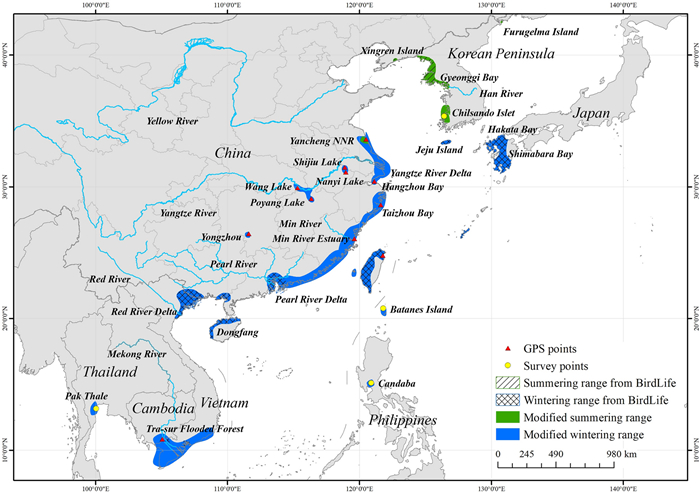
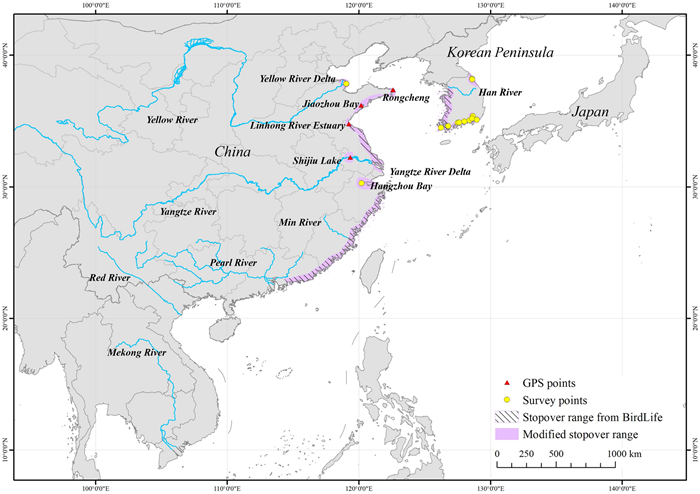
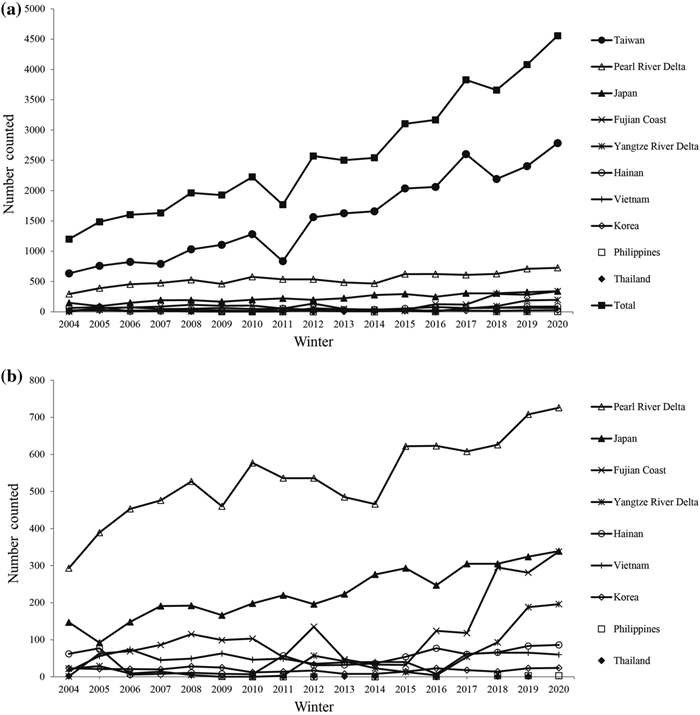

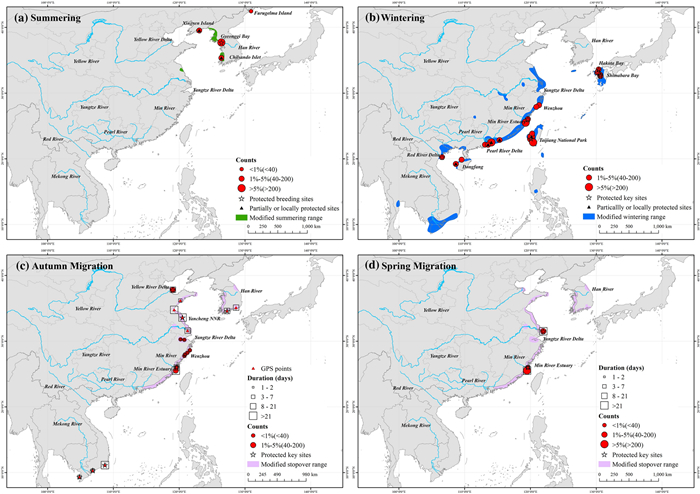
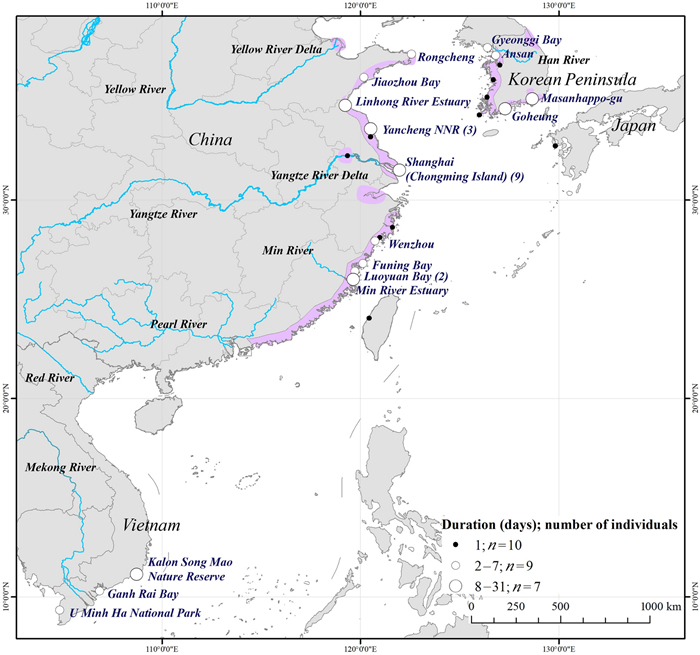





 Email Alerts
Email Alerts RSS Feeds
RSS Feeds